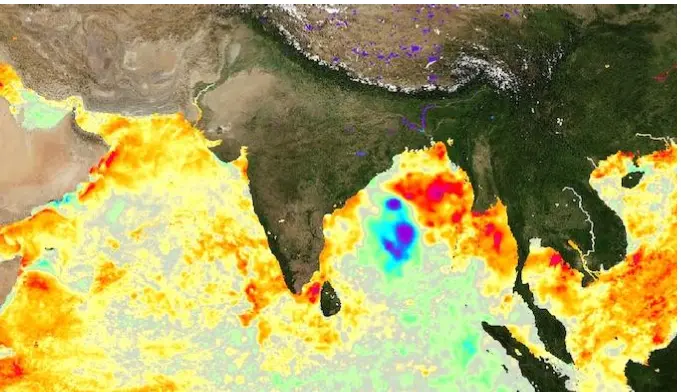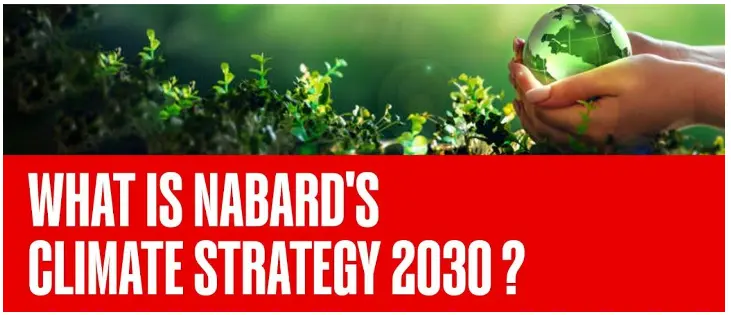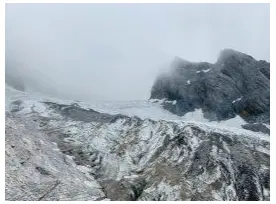Friday, 3rd May 2024
Street Vendors Act and Associated Aspects
In News: The recent celebration of the tenth anniversary of the Street Vendors (Protection of Livelihood and Regulation of Street Vending) Act, 2014 marks a significant milestone in the legal evolution and advocacy efforts of street vendor movements in India, spanning four decades.
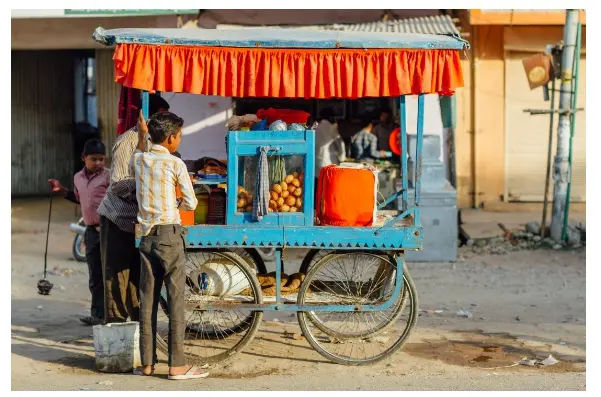
Street Vendors Act Overview
- The Street Vendors Act aims to safeguard and regulate street vending activities across Indian cities, involving local authorities in establishing designated vending zones.
- It recognizes the importance of street vendors to urban life and endeavors to secure their livelihoods while integrating their activities into formal urban planning.
Governance Structure
- The Act establishes Town Vending Committees (TVCs), comprising street vendor representatives, with a mandated 33% representation of women vendors.
- These committees are tasked with including vendors in designated zones and addressing grievances through mechanisms like the Grievance Redressal Committee.
Other Provisions
- The Act delineates the roles and responsibilities of vendors and government entities at different levels.
- States/Urban Local Bodies (ULBs) are required to conduct surveys to identify street vendors at least once every five years.
Implementation Challenges
- Administrative Challenges: Despite legal protections, street vendors often face harassment and eviction due to entrenched bureaucratic views of vending as illegal.
- Governance Integration Issues: The Act struggles to integrate with broader urban governance frameworks, with ULBs lacking power and resources for effective implementation.
- Societal Perception Problems: The societal stigma against street vendors affects urban planning and policy, leading to marginalization.
Ways to Strengthen the Law
- Supportive Implementation: Effective top-down guidance from higher government levels is essential initially, followed by a shift towards decentralized governance.
- Integration with Urban Schemes: Policies and urban planning guidelines must be revised to better incorporate street vending, moving towards inclusive, deliberative processes.
- Addressing New Challenges: Emerging issues such as climate change impacts and competition from e-commerce require innovative use of the Act's provisions.
Challenges Faced by Street Vendors in India
- Legal Limbo and Harassment
- Uncertain Legal Status: Despite the Street Vendors Act, enforcement remains uneven, leaving vendors vulnerable to eviction and harassment.
- Bribes and Extortion: Vendors often face demands for bribes from authorities and local intermediaries.
- Precarious Livelihood and Infrastructure Woes
- Competition and Fluctuating Income: Saturation in certain areas and competition from established businesses lead to economic insecurity.
- Lack of Basic Amenities: Limited access to amenities like clean water and sanitation poses health hazards.
- Navigating the Formal System
- Difficult Licensing Process: The bureaucratic licensing process discourages vendors from formalization.
- Limited Access to Credit: Informal income makes it challenging for vendors to secure loans.
- Gender-Based Discrimination
- Women vendors face gender-based discrimination, affecting their business opportunities and safety.
- Impact of Covid-19
- The pandemic exacerbated economic hardships for street vendors, leading to loss of income and increased poverty.
Steps Needed to Deal with the Problem of Street Vendors
- Formalization and Regulation
- Establishing registration systems and issuing identity cards for vendors, as seen in cities like Hanoi and Ahmedabad.
- Designated Zones
- Creating designated vending zones, as observed in Rio de Janeiro and Kigali, to ensure order and improved pedestrian flow.
- Infrastructure and Support
- Providing access to amenities and offering training and micro-loans for equipment upgrades, modelled after cities like Lima.
- Vendor Associations
- Encouraging vendor associations to facilitate dialogue with authorities and foster collective bargaining.
- Fostering a Collaborative Approach
- Involving local authorities, street vendors, and resident associations in a collaborative approach to street vendor management.
Conclusion
India's approach to street vendor regulation must be tailored to each city's unique characteristics, prioritizing economic stability through skill development and microfinance programs.
Source: TH
SMART (Supersonic Missile Assisted Torpedoes)
In News: The Defence Research and Development Organisation (DRDO) has achieved a successful test of the long-range Supersonic Missile Assisted Torpedo (SMART). This milestone aims to enhance the Navy's anti-submarine warfare capabilities.

Introduction to SMART (Supersonic Missile Assisted Torpedoes)
- Background on Torpedoes
- Torpedoes are self-propelled underwater weapons designed to target and hit specific objectives. However, they are constrained by limited range.
- Overview of SMART
- The SMART system is a technological advancement developed by DRDO to enhance the range and effectiveness of torpedoes.
- It involves launching torpedoes with the assistance of supersonic missiles, thereby extending their operational range significantly.
- Institutions Involved
- Several DRDO laboratories, including Defence Research and Development Laboratory (DRDL), Research Centre Imarat (RCI), Aerial Delivery Research and Development Establishment (ADRDE), and Naval Science and Technology Laboratory (NSTL), have contributed to the development of SMART.
Features of SMART
- The system can be deployed from both coastal locations and warships.
- It consists of a canister-based missile system equipped with advanced subsystems such as two-stage solid propulsion and precision inertial navigation.
- Canisters play a vital role in ensuring the smooth and safe launch of the torpedo and also serve for transportation and storage purposes.
- The canisters are filled with inert gases to provide protection from the external environment during storage and transportation.
- SMART carries a lightweight torpedo missile as its payload and utilizes a parachute-based release mechanism.
Significance of SMART
- The deployment of SMART enables the launch of lightweight torpedoes at targets, such as submarines, located hundreds of kilometres away.
- This capability significantly surpasses the conventional range limitations of lightweight torpedoes.
- SMART is particularly valuable in situations where immediate action against detected enemy submarines is necessary, especially in the absence of other assets.
Source: IE
Article 31C of the Indian Constitution
In News: During a case concerning the government's authority to acquire and redistribute private property, a 9-judge Bench of the Supreme Court opted to address another matter of "radical constitutional consequence": the continued existence of Article 31C.
Article 31C: Upholding Directive Principles
- Introduction and Purpose
- Article 31C was incorporated into the Indian Constitution through the Constitution (25th) Amendment Act of 1971.
- Its primary objective was to safeguard laws enacted to uphold specific directive principles, notably those outlined in Articles 39(b) and 39(c).
- These principles emphasize the equitable distribution of material resources and the prevention of their concentration to the detriment of the common good.
- Background and Context
- The genesis of Article 31C can be traced back to the legal challenges faced in implementing certain laws, notably highlighted in the landmark "Bank Nationalisation Case.
- " The 25th Amendment responded to these challenges by addressing the hurdles encountered in realizing directive principles, particularly concerning the equitable distribution of resources and the prevention of excessive concentration of wealth.
- Legal Challenges and Amendments
- Subsequent legal challenges, notably the Kesavananda Bharati case in 1973, prompted modifications to Article 31C. The 42nd Amendment Act of 1976 expanded the protective ambit of Article 31C, extending its coverage to encompass all directive principles.
- This expansion aimed to shield directive principles from legal challenges based on Articles 14 and 19 of the Constitution, which pertain to the right to equality and certain freedoms, respectively.
- Legal Evolution and Controversies
- The evolution of Article 31C encountered significant legal controversies, notably culminating in the Minerva Mills v. Union of India case in 1980.
- This case resulted in the partial striking down of Article 31C, questioning the extent of Parliament's authority to amend the Constitution.
- The ruling raised pertinent questions about the limitations of constitutional amendments and their potential implications for fundamental rights and directive principles.
- Current Legal Discourse
- Presently, the Supreme Court is engaged in deliberations concerning the interpretation and validity of Article 31C, particularly in the context of specific laws, such as those related to property acquisition in Maharashtra.
- Arguments presented before the court revolve around the applicability of the doctrine of revival and the impact of previous judicial pronouncements on the standing of Article 31C.
- The outcome of these deliberations holds significance for the balance between fundamental rights and directive principles enshrined in the Indian Constitution.
Source: IE
Regenerative Blue Economy
In News: The International Union for Conservation of Nature (IUCN) has published a report presenting a roadmap for the development of a Regenerative Blue Economy (RBE).

Key Highlights of the Report
- Proposal of a Hierarchy
- The report suggests a hierarchical structure for categorizing interpretations and levels of sustainability within the Blue Economy concept.
- It delineates three main tiers: Ocean/Brown Economy, Sustainable Blue Economy, and Regenerative Blue Economy.
- Ocean/Brown Economy
- This tier encompasses economic activities related to the ocean, including traditional maritime sectors like shipping, ports, fisheries, and offshore oil/gas.
- It primarily focuses on economic contributions without significant considerations for sustainability.
- Sustainable Blue Economy
- The Sustainable Blue Economy incorporates principles of environmental sustainability and ecosystem protection.
- It extends beyond economic activities to include conservation and restoration of marine/coastal ecosystems and the valuation of ecosystem services.
- This tier aligns with UN Sustainable Development Goals, particularly SDG 14.
- Regenerative Blue Economy
- The Regenerative Blue Economy aims to actively restore and revitalize marine ecosystems while promoting sustainable, low or no carbon economic activities.
- Its founding principles emphasize protection and restoration, inclusive economic systems, inclusive and participatory governance, and prioritizing low or no carbon activities.
- Spectrum of Sustainability
- The report acknowledges various sustainability levels within the Blue Economy concept, with the Regenerative Blue Economy representing the most ambitious and restorative approach.
- Principles of Blue Economy
- It states that various organizations propose sets of principles for the Blue Economy concept, emphasizing common themes such as ecosystem health, sustainability, inclusivity, and good governance.
- Blue Carbon and Nature-based Solutions
- The report underscores the importance of valuing coastal/marine ecosystem services like carbon sequestration.
- It highlights Blue Carbon as an emerging market opportunity and component of sustainable economies, aligning with broader Nature-based Solutions for climate change and biodiversity.
- Key Sectors and Considerations
- The report outlines considerations for key sectors within the Blue Economy, including fishing and aquaculture, maritime transport, and the establishment of Marine Protected Areas (MPAs) to offset extractive activities.
- Connections to Other Approaches
- It emphasizes the need to integrate Blue Economy principles with those of the circular economy, Bioeconomy, and Social and Solidarity Economy (SSE) for holistic and sustainable development.
Initiatives Promoting Regenerative Blue Economy
- Global Initiatives
- IUCN Nature 2030
- Great Blue Wall Initiative
- Clean Seas Campaign
- Moroni Declaration and Cape Town Manifesto
- India
- Maritime India Vision 2030
- Deep Ocean Mission
- Pradhan Mantri Matsya Sampada Yojana
- Integrated Coastal Zone Management (ICZM)
- Blue Economy 2.0
|
UPSC Previous Year Questions Prelims (2019) Q. What is blue carbon? (a) Carbon captured by oceans and coastal ecosystems Ans: (a) Prelims (2023) Q. ‘Invasive Species Specialist Group’ (that develops Global Invasive Species Database) belongs to which one of the following organizations? (a) The International Union for Conservation of Nature (b) The United Nations Environment Programme (c) The United Nations World Commission for Environment and Development (d) The World Wide Fund for Nature Ans: (a) Mains (2018) Q. Defining blue revolution, explain the problems and strategies for pisciculture development in India. |
Source: IUCN
International Labour Day
In News: Recently, International Labour Day was observed worldwide to recognize and honor the invaluable contributions made by workers across the globe.
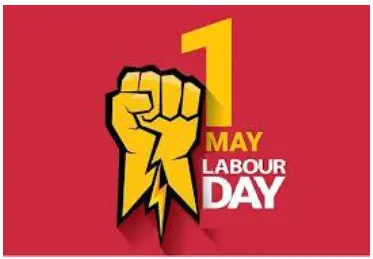
International Labour Day Overview
- International Labour Day, also known as Workers Day or May Day, is celebrated globally on May 1st each year.
- It's dedicated to honoring the efforts and achievements of workers and the labour movement.
- More than 80 countries, including India, Cuba, and China, observe International Labour Day.
- On this day, people worldwide participate in marches to advocate for working-class rights and to protect them from exploitation.
History of International Labour Day
- The origins of International Labour Day trace back to the late 19th-century labour movement in the United States.
- In 1886, a significant demonstration took place where workers demanded an eight-hour workday.
- The demonstration escalated, resulting in the Haymarket Affair in Chicago, causing injuries to many people.
- The Haymarket Affair incident marked the inception of International Labour Day.
- In 1889, various socialist parties in Europe collectively decided to celebrate May 1st as International Labour Day.
- Since then, the day has been observed annually on May 1st.
International Labour Organization (ILO) Key Facts
- The ILO is a specialized agency of the United Nations (UN) dedicated to improving labour conditions and living standards globally.
- Established in 1919 by the Treaty of Versailles, it became the first affiliated specialized agency of the UN in 1946.
- The organization is committed to advancing opportunities for both women and men to obtain decent and productive work in conditions of freedom, equity, security, and human dignity.
- Its main objectives include promoting rights at work, encouraging decent employment opportunities, enhancing social protection, and strengthening dialogue on work-related issues.
- The ILO provides technical assistance in social policy and administration, workforce training, and fosters cooperative organizations and rural industries.
- Additionally, it compiles labour statistics, conducts research on various social problems, and helps protect the rights of international migrants and organized labour.
- In recognition of its activities, the ILO was awarded the Nobel Prize for Peace in 1969.
Source: NDTV
What is Antares?
In News: The Indian Institute of Astrophysics (IIA), headquartered in Bengaluru, has captured footage of the moon passing in front of Antares, a prominent red star.

About Antares
- Antares, also known as Alpha Scorpii, holds the distinction of being the alpha, or brightest, star in the Scorpius constellation and ranks as the 15th-brightest star in the entire night sky.
- It stands as a massive red supergiant star, boasting immense size and luminosity.
- Its brightness is about 10,000 times greater than that of our sun.
- Antares is among the largest stars known, with a diameter approximately 700 times that of the sun, large enough to encompass the orbit of Mars if our solar system were centered on it.
- Positioned roughly 600 light-years away from Earth, Antares shines from a significant distance.
- Despite its massive size, the overall density of Antares is astonishingly low, measuring less than one-millionth that of the sun.
- This star's surface temperature is relatively cool compared to other stars, approximately 6,100 degrees F (3,400 degrees C), which gives it its distinctive ruddy hue, in contrast to the sun's higher surface temperature of about 10,000 degrees F (5,500 degrees C).
What is a Red Supergiant Star?
- Red supergiant stars are celestial giants approaching the later stages of their stellar life cycles.
- They exhibit a vast radius, ranging from several hundred to 1,500 times that of the Sun.
- Despite their immense size, the red coloration signifies these stars possess relatively low surface temperatures.
- Red supergiants are renowned for their high luminosity, emitting substantial amounts of light.
- Many red supergiants are categorized as variable stars, displaying fluctuations in brightness as observed from Earth.
- These stars are actively shedding mass, with nebulae often observed surrounding them as they expel material into space.
Source: TH
Space Applications Centre
In News: According to a study conducted by scientists at the Space Applications Centre, it has been suggested that the extent of water ice in the northern polar region of the Moon is double that found in the southern polar region.
- About Space Applications Centre (SAC)
- SAC is a significant research and development center under the Indian Space Research Organisation (ISRO), located in Ahmedabad, Gujarat.
- It operates across two campuses and engages in multi-disciplinary activities.
- Genesis
- The origins of SAC can be traced back to 1966 when the Experimental Satellite Communication Earth Station (ESCES) was established by Dr. Vikram Sarabhai in Ahmedabad.
- In 1972, various ISRO units in Ahmedabad focused on space technology applications merged to form SAC.
- Core Competence and Activities
- SAC specializes in developing spaceborne and airborne instruments/payloads for national development and societal benefits.
- Its applications cater to communication, navigation, and remote sensing needs of the country.
- The center contributes significantly to ISRO's scientific and planetary missions, including Chandrayaan-1 and the Mars Orbiter Mission.
- Communication transponders developed at SAC for Indian National Satellite (INSAT) and Geo Synchronous Satellite (GSAT) series are utilized by the government and private sector for various purposes like VSAT, DTH, and broadcasting.
- SAC designs and develops optical and microwave sensors, signal and image processing software, GIS software, and applications for the Earth Observation (EO) program.
- These applications span diverse areas such as Geosciences, Agriculture, Environment and Climate Change, Oceanography, and Atmosphere studies.
- Facilities
- SAC boasts highly sophisticated payload integration laboratories, electronic and mechanical fabrication facilities, environmental test facilities, and systems reliability/assurance groups.
- It also houses image processing and analysis facilities, project management support groups, and a well-equipped library.
- Training and Collaborations
- SAC serves as a host institution for training programs for students from the Asia Pacific region, focusing on satellite meteorology and communication under the Centre for Space Science and Technology Education in Asia and the Pacific (CSSTE-AP).
Source: FP
Kutch Ajrakh
In News: Recently, the Controller General of Patents, Designs, and Trademarks (CGPDTM) has awarded the Geographical Indication (GI) certificate to the traditional artisans of 'Kutch Ajrakh,' who originate from the dynamic region of Kutch in Gujarat.
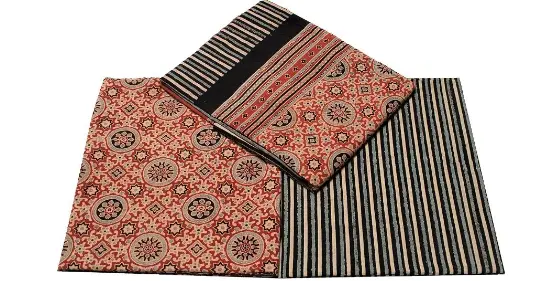
- About Kutch Ajrakh
- Kutch Ajrakh is a traditional textile craft deeply ingrained in the cultural heritage of Gujarat, particularly prevalent in regions such as Sindh, Barmer, and Kutch, where its legacy spans thousands of years.
- This art form involves a meticulous process of hand-block printing on treated cotton fabric, resulting in elaborate designs imbued with rich symbolism and historical significance.
- Origins and Meaning
- The term "Ajrakh" finds its roots in the word "Azrak," which means indigo, a commonly used dye that imparts a bluish hue to the fabric.
- Traditional Ajrakh prints typically incorporate three primary colors: blue symbolizing the sky, red symbolizing the earth and fire, and white symbolizing the stars.
- Craftsmanship and Techniques
- Textiles undergo treatment with vegetable and mineral-based colors, followed by a series of about eight washing cycles to achieve the desired color fastness and vibrancy.
- This craft was introduced to the region over 400 years ago by Sindhi Muslims, contributing to its rich cultural heritage and historical significance.
- Cultural Significance and Usage
- Nomadic pastoralist and agricultural communities such as the Rabaris, Maldharis, and Ahirs commonly adorn themselves with Ajrakh-printed cloth, using it for turbans, lungis, or stoles, thus reflecting its integral role in everyday life and cultural identity.
Source: TOI
Hindu Marriage Act, 1955
In News: Recently, the Supreme Court clarified that the mere registration of a marriage without a proper ceremony would not be considered valid under the Hindu Marriage Act.
About Hindu Marriage Act, 1955 (HMA Act)
- The Hindu Marriage Act, 1955 (HMA Act) is legislation that codifies laws pertaining to marriage within the Hindu community.
- It encompasses regulations not only concerning the ceremonies and registration of Hindu marriages but also establishes guidelines for divorce.
Salient Features
- Individuals who are Hindus by birth or through conversion are governed by the HMA Act.
- The Act's definition of Hindu includes individuals following the Buddhist, Jain, and Sikh faiths.
Marriageable Age
- According to the HMA Act, the bridegroom must be a minimum of 21 years old, and the bride must be at least 18 years old at the time of marriage.
- Marriage involving minors is punishable by imprisonment of up to three years and/or a fine of up to Rs 1 lakh.
Significance of Ceremonies
- The HMA Act recognizes and respects customary practices, including long-standing customs (Reeti-Riwaz) within Hindu marriages.
- Saptapadi, the ritual of the bride and groom taking seven steps around the holy fire, is a crucial aspect of Hindu marriage ceremonies, though ceremonies may vary according to customs.
Forbidding Bigamy
- The Act prohibits the practice of bigamy, polygamy, or polyandry, ensuring that individuals cannot have multiple spouses simultaneously.
- Section 5 of the Act makes it illegal to have two living spouses at the same time, punishable under Sections 494 and 495 of the Indian Penal Code, 1860.
Focus on Mental Stability
- A marriage is deemed null and void if one or both parties are mentally unfit at the time of marriage, necessitating legal consent before marriage.
Registration
- While registration of Hindu marriages is subject to state laws, lack of an official certificate does not invalidate or make a marriage illegal.
Divorce
- The HMA Act permits divorce through mutual consent and allows for judicial separation if divorce cannot be mutually agreed upon within one year of marriage.
- Divorce may be granted before one year under special circumstances of exceptional hardship, and the Act delineates various grounds for divorce.
Restitution of Conjugal Rights
- The Act includes provisions for restitution of conjugal rights, allowing a spouse to seek court intervention if the other spouse unjustifiably leaves.
Legal Procedures
- Matters related to Hindu marriages and divorce are adjudicated in family courts in India, with jurisdiction based on the location of marriage celebration, the residence of one of the parties, or the last shared residence of the spouses.
Source: DH
Red Colobus
In News: A recent study conducted by an international team of scientists has suggested that conserving red colobus monkeys could play a crucial role in safeguarding tropical forests.
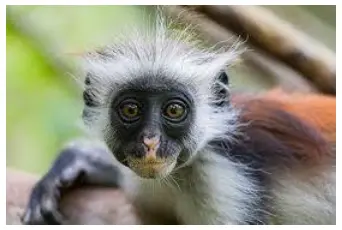
- About Red Colobus
- Red colobus monkeys, a rare and endangered group of primates found across Africa, serve as important indicators of biodiversity.
- They belong to one of the two major simian groups globally, with colobines primarily being leaf-eaters, distinguishing them from the omnivorous cercopithecines.
- In addition to Africa's red colobus monkeys, colobines also include langurs found in South and Southeast Asia.
- Distribution
- Red colobus monkeys are distributed across forests from Senegal to the Zanzibar Archipelago, encompassing diverse habitats.
- Threats
- Most red colobus populations face extinction due to threats such as hunting for trade and local subsistence, as well as habitat loss, degradation, and fragmentation caused by various human activities.
- Initiative to Conserve Red Colobus
- The Red Colobus Conservation Action Plan, spearheaded by the International Union for Conservation of Nature (IUCN) Species Survival Commission Primate Specialist Group and the African Primatological Society, aims to prioritize red colobus conservation efforts.
- The action plan seeks to secure Africa's tropical forests and mitigate unsustainable hunting for wild meat.
- Conservation Efforts
- A Red Colobus Working Group (RCWG) has been established to oversee the implementation of the action plan.
- Additionally, a Red Colobus Conservation Network (RCCN) has been formed to facilitate communication, capacity-building, and monitoring of red colobus conservation initiatives.
Source: DTE
Addressing the Gap: Reforming the EC's Model Code and Fostering Model Leadership in India
In News: The Model Code of Conduct (MCC), vital for fair elections in India, has evolved over time but faces challenges today. Analysing its history, identifying current issues, and proposing enforcement measures are crucial.
Origins and Expansion Of MCC
- The MCC emerged in the 1960s as basic guidelines for election conduct, initially applied in Kerala's Assembly elections.
- Over time, it grew in scope and importance under various Chief Election Commissioners (CECs).
Challenges and the Need for Strengthening Enforcement
- Escalating Violations
- Political parties and candidates frequently disregard the MCC's provisions, engaging in activities like hate speech and misinformation campaigns.
- Exploitation of Loopholes
- Modern political actors exploit MCC loopholes, especially with the advent of technology and social media.
- Inadequate Deterrents
- The MCC lacks meaningful consequences for violations, leading to a perception of impunity among politicians.
- Complexity of Enforcement
- India's diverse electoral landscape strains the Election Commission's (EC) enforcement capabilities, with lengthy adjudication processes.
- Erosion of Public Trust
- Widespread disregard for the MCC erodes public confidence in the electoral process, fostering voter apathy.
Proposed Reforms to Strengthen Enforcement
- Clear and Comprehensive Guidelines
- Establishing clear and updated guidelines on permissible conduct during electoral campaigns.
- Strict Enforcement Mechanisms
- Imposing proportional penalties for violations and streamlining enforcement procedures for swift adjudication.
- Indirect Liability for Political Parties
- Holding parties accountable for MCC violations regardless of individual culpability.
- Transparency and Public Accountability
- Maintaining a publicly accessible database of MCC violations to bolster transparency.
- Timely and Credible Adjudication
- Prioritizing prompt resolution of cases to maintain the MCC's deterrent effect.
- Continuous Evaluation and Revision
- Continuously updating the MCC to address emerging challenges and changing electoral dynamics.
The Role of Political Parties and Election Commission
- The Role of Political Leadership
- Promoting ethical standards and responsible conduct within parties to inspire confidence in the electoral process.
- The Role of Election Commission
- Impartially adjudicating MCC violations and enforcing regulations to uphold electoral integrity.
- Enhancing the EC's Capacity
- Investing in training, technological infrastructure, and human resources to adapt to evolving challenges.
Conclusion
Strengthening the MCC through reforms and fostering ethical leadership can reinforce India's democratic processes and ensure free and fair elections for all citizens.
Source: IE
Share the article
Edukemy’s Current Affairs Quiz is published with multiple choice questions for UPSC exams
MCQ
Get Latest Updates on Offers, Event dates, and free Mentorship sessions.

Get in touch with our Expert Academic Counsellors 👋
FAQs
UPSC Daily Current Affairs focuses on learning current events on a daily basis. An aspirant needs to study regular and updated information about current events, news, and relevant topics that are important for UPSC aspirants. It covers national and international affairs, government policies, socio-economic issues, science and technology advancements, and more.
UPSC Daily Current Affairs provides aspirants with a concise and comprehensive overview of the latest happenings and developments across various fields. It helps aspirants stay updated with current affairs and provides them with valuable insights and analysis, which are essential for answering questions in the UPSC examinations. It enhances their knowledge, analytical skills, and ability to connect current affairs with the UPSC syllabus.
UPSC Daily Current Affairs covers a wide range of topics, including politics, economics, science and technology, environment, social issues, governance, international relations, and more. It offers news summaries, in-depth analyses, editorials, opinion pieces, and relevant study materials. It also provides practice questions and quizzes to help aspirants test their understanding of current affairs.
Edukemy's UPSC Daily Current Affairs can be accessed through:
- UPSC Daily Current Affairs can be accessed through Current Affairs tab at the top of the Main Page of Edukemy.
- Edukemy Mobile app: The Daily Current Affairs can also be access through Edukemy Mobile App.
- Social media: Follow Edukemy’s official social media accounts or pages that provide UPSC Daily Current Affairs updates, including Facebook, Twitter, or Telegram channels.

